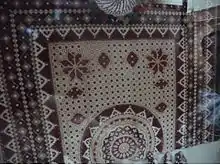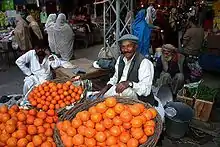Saraiki culture
Saraiki culture is the culture of the Saraiki people, residing in Pakistan and outside Pakistan. 6 March is Saraiki Culture Day.


Religion

Almost 99% population in Saraikistan region is Muslim. Islam came to this region with the Arab conquest of Sindh in eighth century. Majority of Muslims are Sunnis while Shia population is also in considerable size. The region is home to many Sufism. There is a saying in Persian that Multan is the 'city of dust (because of its sandy climate), summer, beggars and graveyards' (Gard, Garma, Gada o Goristan).[1] It is also called as the city of saints (madinatul Auliya مدینۃالاولیا). The city has been a focal point for many religions, in particular becoming a central abode for Sufism, the mystical side of Islam. The city has attracted Sufi saints from far places of the globe. One of the first Sufi saints to arrive in Multan was Shah Gardez who is considered as the founder of Muslim Multan according to a BBC world documentary. Multan has been the centre of Suhrawardiyya, one of the major Sufi orders, called as Tariqa. It has the shrines of Baha-ud-din Zakariya and Shah Rukn-e-Alam.
Similarly, Uch Sharif has been the centre of Qadiriyya Sufi order. Allama Iqbal while referring to the two great Sufi saints of Saraiki region, Khwaja Ghulam Farid and Muhammad Suleman Taunsvi, said that this region can not be empty from spirituality. The tomb of Sakhi Sarwar in Dera Ghazi Khan is also very popular shrine in Pakistan.
Clothing
People usually wear Shalwar kameez, which is the national dress of Pakistan. The traditional male dress is Lungi with Chola (kameez). The tradition male dresses suthanr shalwar, Ghayiroli Saraiki Shalwar Suthanr Shalwar. The tradition put Rumal or Pashmina or Shaal on shoulder. Shalwar with Kamez. Chadar is also an important part of male and female dress. Women wear bochanrr, Chunni (Chunri)and men wear Patka on the head. Women also used to wear ghagra but it is not used only for wedding and parties. Ajrak and Topi is also worn by people. Saraiki men also like to have moustaches locally saying (muchaan), and little beard and the dressing of the hairs(waal) are short cut. Somewhere these are long cut by the own desire of them.
Cuisine
Flowers of Sohanjrraan or Sohanjna (Moringa oleifera) is one of the most famous vegetable dish in South Punjab. Sohan Halwa is traditional sweet made by boiling a mixture of water, sugar, milk and cornflour until it becomes solid. Multn region is also famous for its sweet juicy Mangoes specially "Chaunsa" or "Chorsa".
Traditional sports
Deeti Danna (Saraiki: ݙیٹی ݙنا)is one of the famous traditional sports especially for boys in rural areas along with other sports like Baandar Killa [باندر کلّا], Pittu Garam [پٹّو گرم], Stapu [سٹاپو] and Kabaddi [کبڈی], Datthi Ghori, Assu Panju etc.
Art and music
Jhumar
Jhumar or Jhoomar is the traditional Saraiki folk dance. It is a lively form of music and dance that originated in the Multan and Balochistan. It is slow and rhythmic. The word "Jhumar" comes from jhum/jhoom, which means swaying. The songs evoke a quality reminiscent of swaying. The content of these songs is varied; they are usually love with emotional songs, too. The Jhumar is a dance of ecstasy. Jhumar is performed usually at the wedding ceremonies. It is a living demonstration of the happiness. The dance is mostly performed by the Balochi and Saraiki people of Southern Punjab. The emphasis of Jhumar is recreating the gaits of animals and birds. The movement of animals, the ploughing of the field, sowing of seeds and harvesting are shown in the original progression. The dance is also performed in circle, to the tune of emotional songs. Another Saraiki dance is Poochhra which is performed mostly on weddings. One woman holds back hanging part of Kameez of another woman and that second woman dances by jumping to right and left. Performed exclusively by men, it is a common feature to see three generations — father, son and grandson — dancing together at weddings. The dance is without acrobatics. Each region of Southern Punjab has its own variation of Jhumar. The movement of the arms only is considered its main forte. Feet are musically placed in front and backwards, and turns are taken to the right. Sometimes the dancers place one hand below the ribs on the left and gesticulate with the right hand. This dance does not tire out its performers, and it is normally danced on moonlight nights in the villages away from the habitation. The dancers let-off a sound, "Dee Dee," in tune with the beat of the dance which adds to its grace.
Saraiki music
Notable singers include:
- Attaullah Khan Esakhelvi
- Saein Zahoor also Sain Zahoor or Zahur - who was nominated and won "best BBC voice of the year in 2006
- Mansoor Ali Malangi
- Pathanay Khan
- Abida Parveen
- Pathanay Khan
- Shazia Khushk
Saraiki poetry
Most popular Saraiki poet also known as God Father of Saraiki poetry is Shakir Shuja Abadi who despite being paralyzed is a great poet. He has written many books in Saraiki Poetry, mostly themed on Sufism.
Charpai and Hamacha
In the city there is Charpai, locally known as khatt کھٹ, Khatrra کھٹڑا and Hamacha culture ماچا. Charpai and Hamacha means a big heavy wooden bed wooven with "wanrr" ((ropes) made of date-tree leaves or Koondr long leaves), which are kepts at Chowks and Baithaks. You can find these Hamachas in every baithaks (guest room), Dera, and even chowks and wisakh.
Normally people sit on charpai and hamacha in the evening and gossip. There they discuss their daily personal, social or political issues in friendly environment. The biggest charpai of the world is in Dera Ghazi Khan according to Guinness World Records.
See also
- Saraikistan
- Saraiki people
- List of Saraiki people
- Saraiki cuisine
- Saraiki diaspora
- List of Seraiki tribes
- Saraiki literature
References
- "Gard, Garma, Gada o Goristan - The gates". The Nation. Retrieved 2013-03-24.
